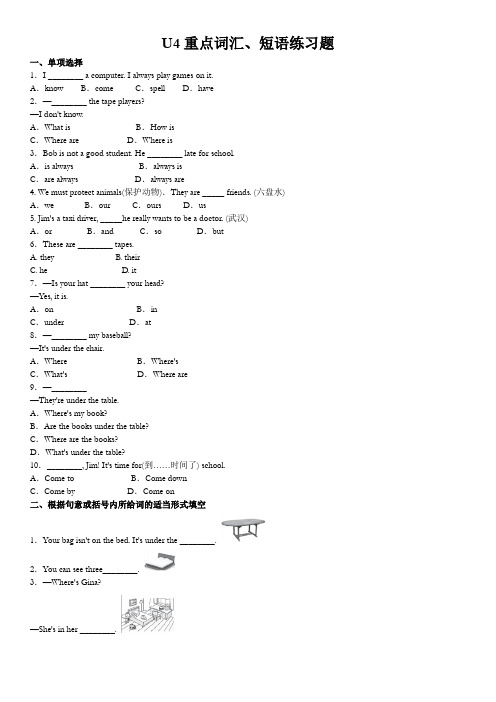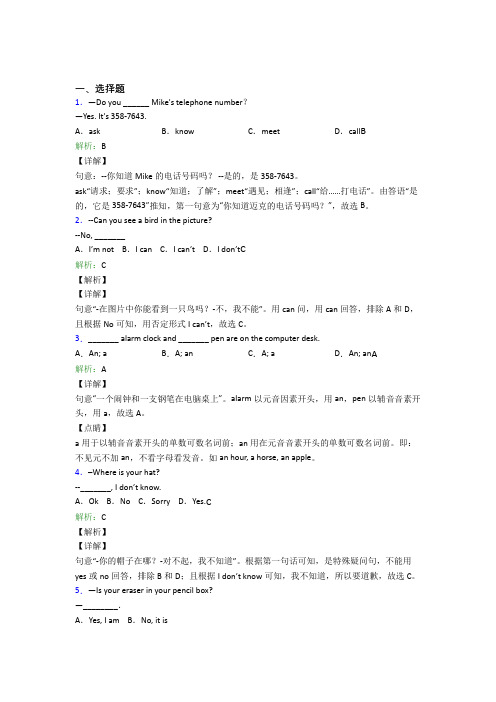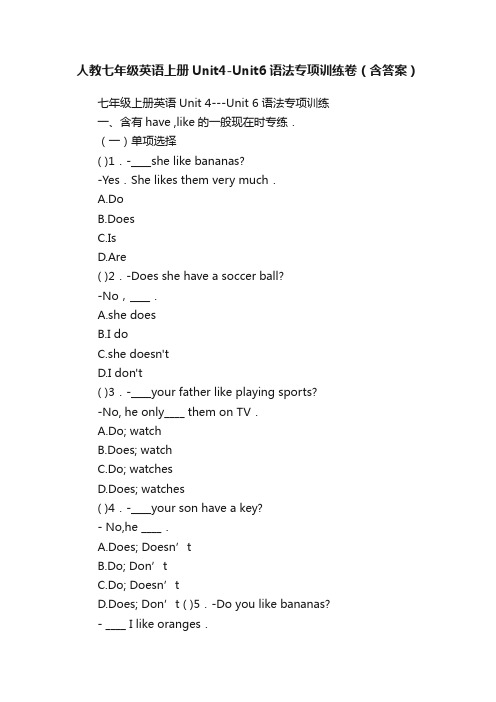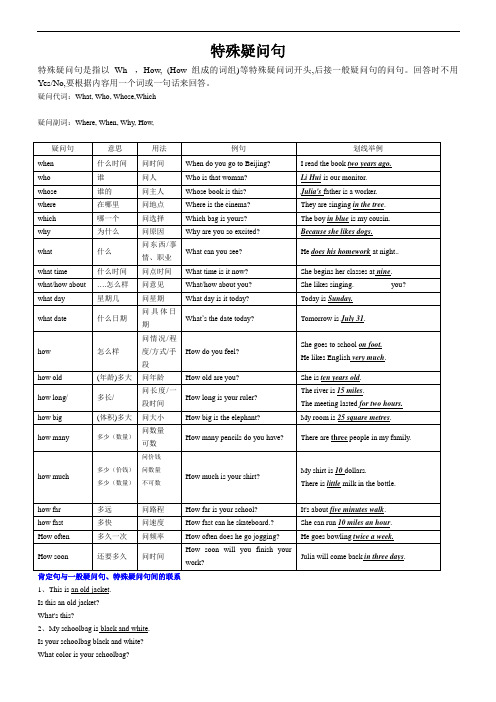七年级上册英语unit4单元语法精练习题(含答案)
2020年人教版英语七年级上册Unit 4重点词汇、语法自测(附答案)

U4重点词汇、短语练习题一、单项选择1.I ________ a computer. I always play games on it.A.know B.come C.spell D.have2.—________ the tape players?—I don't know.A.What is B.How isC.Where are D.Where is3.Bob is not a good student. He ________ late for school.A.is always B.always isC.are always D.always are4. We must protect animals(保护动物).They are _____ friends. (六盘水)A.we B.our C.ours D.us5. Jim's a taxi driver, _____he really wants to be a doctor. (武汉)A.or B.and C.so D.but6.These are ________ tapes.A. theyB. theirC. heD. it7.—Is your hat ________ your head?—Yes, it is.A.on B.inC.under D.at8.—________ my baseball?—It's under the chair.A.Where B.Where'sC.What's D.Where are9.—________—They're under the table.A.Where's my book?B.Are the books under the table?C.Where are the books?D.What's under the table?10.________, Jim! It's time for(到……时间了) school.A.Come to B.Come downC.Come by D.Come on二、根据句意或括号内所给词的适当形式填空1.Your bag isn't on the bed. It's under the ________.2.You can see three________.3.—Where's Gina?—She's in her ________.4.There are two ________ in this room.5.Where are my________?6.Is it your ________?7.The ________ ________ is on the teacher's desk.8.Those are my grandfather's ________.9.I put some ________ in the box.10.My brother's ________ ________ is on the table.三、选择适当的词组完成句子,everywhere,ask,plane,tidy,we 1.Her room is ________.2.Where's your model________?3.His pencils are___________—on the desk, under the desk and on the floor. 4.“Where’s my yellow jacket?” the girl_________.5.This is________ school. It's beautiful(美丽的).四、按要求完成句子1.The baseball is under the bed.(改为一般疑问句)________________________________________2.The dictionaries are on the desk.(就画线部分提问)__________________________________________3.—Where are my notebooks? (补全答语)—______ ________ in your schoolbag.4.The books are under the table.(改为否定句)_________________________________________5.I think he is from America.(改为否定句)______________________________________6.我的书桌在房间里。
初中英语七年级上册Unit 4(含答案解析)

一、选择题1.—Do you ______ Mike's telephone number?—Yes. It's 358-7643.A.ask B.know C.meet D.call B解析:B【详解】句意:--你知道Mike的电话号码吗? --是的,是358-7643。
ask“请求;要求”;know“知道;了解”;meet“遇见;相逢”;call“给……打电话”。
由答语“是的,它是358-7643”推知,第一句意为“你知道迈克的电话号码吗?”,故选B。
2.--Can you see a bird in the picture?--No, _______A.I’m not B.I can C.I can’t D.I don’t C解析:C【解析】【详解】句意“-在图片中你能看到一只鸟吗?-不,我不能”。
用can问,用can回答,排除A和D,且根据No可知,用否定形式I can’t,故选C。
3._______ alarm clock and _______ pen are on the computer desk.A.An; a B.A; an C.A; a D.An; an A解析:A【详解】句意“一个闹钟和一支钢笔在电脑桌上”。
alarm以元音因素开头,用an,pen以辅音音素开头,用a,故选A。
【点睛】a用于以辅音音素开头的单数可数名词前;an用在元音音素开头的单数可数名词前。
即:不见元不加an,不看字母看发音。
如an hour, a horse, an apple。
4.–Where is your hat?--_______, I don’t know.A.Ok B.No C.Sorry D.Yes.C解析:C【解析】【详解】句意“-你的帽子在哪?-对不起,我不知道”。
根据第一句话可知,是特殊疑问句,不能用yes或no回答,排除B和D;且根据I don’t know可知,我不知道,所以要道歉,故选C。
Unit 4 Seasons 同步练习 (含语法讲解) 牛津深圳版英语七年级上册

Unit4 Seasons基础训练一、选词填空1. It is often(snow, snowy) in February in Harbin.2. The sun is shining brightly. It is a (windy, sunny) day.3. Shall we go on a (picnic, visit) tomorrow? Let’s go to the supermarket to buy some food and drinks.4. When I walk on the beach, I leave a lot of sandy (footprints, feet) on it.5. I love (picking, kicking) the leaves all around when it is autumn.二、从方框中选择适当的单词完成下列句子。
如有必要,须改变单词的形式。
每个单词仅使用一次。
A.B.The strong wind can _______________the roof of the house away.C.The sea is ________________in the light of the Moon.D.How long are you going to ____________your holiday in Bangkkok?E.Now, ______________the ball and start the game.F.I don’t have any friends or _____________in this city.G.The weather is quite ______________. It is easy to catch fire.H.It is so hot ___________the day. I don’t want to go out at all.I.It is raining outside. It is __________everywhere.J.It is __________these days and the snow in the streets stops the traffic.K.There are a lot of _____________on the ground after the heavy rain.L.Canberra is the capital of _____________.M.If you walk on the soft snow, you will leave a lot of _____________on it.N._____________in this house is new.O.Do you live in a _________________or a city?三、单词拼写1. We must p________ the Earth.2. Sarah listens to the weather r________ every morning so she knows it is rainy today.3. I’ll get you a l______ box to put in all your CDs.4. E________ outside is wet after the heavy rain.5. I hope you’ll have a good time d_______ your trip in Guilin.四、完成句子1. 太阳为我们提供能量。
人教七年级英语上册Unit4-Unit6语法专项训练卷(含答案)

人教七年级英语上册Unit4-Unit6语法专项训练卷(含答案)七年级上册英语Unit 4---Unit 6 语法专项训练一、含有have ,like的一般现在时专练.(一)单项选择( )1.-____she like bananas?-Yes.She likes them very much.A.DoB.DoesC.IsD.Are( )2.-Does she have a soccer ball?-No,____.A.she doesB.I doC.she doesn'tD.I don't( )3.-____your father like playing sports?-No, he only____ them on TV.A.Do; watchB.Does; watchC.Do; watchesD.Does; watches( )4.-____your son have a key?- No,he ____.A.Does; Doesn’tB.Do; Don’tC.Do; Doesn’tD.Does; Don’t ( )5.-Do you like bananas?- ____ I like oranges.A.No, it isn't.B.Yes, it is.C.No,I don't.D.Yes,I don't.( )6.-Does Jack____a TV?-Yes.He often____sports programs on TV.A.has; watches B.have; watchC.have; watches D.has; watch( )7.- ____ your grandmother like watching ball games?-____.She doesn't like watching ball games.A.Does; No, she doesn't B.Doesn't; Yes, she doesn't C.Does; Yes, she does D.Doesn't; No, she does( )8.-Do you have a baseball?-____.But I don't have a baseball bat.A.Yes,I amB.No, I'm notC.Yes,I do D.No,I don't ( )9.- ____your sister like dancing?-Yes, but I____.A.Do; don'tB.Does; don'tC.Does; am not( ) 10.My uncle____watching CBA on TV, but my aunts____watching soap operas(肥皂剧).A.like; likeB.likes; likesC.like; likesD.likes; like(二)按要求完成句子,每空一词11.Jeff has two computers.(改为一般疑问句)____ Jeff____ two computers?12.-Does Tom have a watch?(作肯定回答)- ____,he____.13.-Do Lily and Linda like fruit salad?(作否定回答)-No,_____ ____.14.The boy likes tomatoes for breakfast.(改为一般疑问句)____ the boy____ tomatoes for breakfast?15.We have some photos of TFBOYS.(改为否定句)We____ ____ any photos of TFBOYS.二、可数名词与不可数名词专练(一)单项选择( )1.A set of ____ on the table.A.key isB.keys isC.keys areD.key are( )2.Look! Some____ in the schoolbag.A.dictionary is B.dictionaries isC.dictionaries are D.dictionarys are( )3.-Where____my pencils?- ____on the table.A.is;It's B.are:It'sC.is; They're D.are;They're( )4.-Maria, what vegetables do you like?-I like____very much./doc/ae10758672.html,kB.riceC.applesD.carrots( )5.-Do you like vegetables?-Yes.I love____.A.orangesB.eggsC.carrotsD.hamburgers( )6.Jack has some____ for lunch.And he likes them very much. A.fruit B.chicken C.tomatoes /doc/ae10758672.html,k( )7.We don't have____.Let's go and buy(买)some tomatoes and carrots.A.vegetablesB.fruitC.hamburgersD.bread( )8.-What____ do you like, David?- Oranges.A.classB.colorC.fruitD.vegetable( )9.He likes____ for lunch, but I like____.A.carrot; chickens B.carrot; chickenC.carrots; chicken D.carrots; chickens( ) 10.That is my____and those are my____.A.daughters; sonsB.daughter; sonsC.daughter; son D.daughters; son(二)用括号内所给词的适当形式填空11.He has some________ (rice) and two eggs.12.Are these your________ (strawberry)?13.Three________ (tomato) are on the table.14.These are two________(photo) of my family.15.Their________ (dictionary) are on the sofa.(三)按要求完成句子16.This is my good friend.(改为复数句)__________________________________________________________17.That is a yellow jacket.(改为复数句)__________________________________________________________ 18.It is an English-Chinese dictionary.(改为复数句)__________________________________________________________ 19.A tomato is on the table.(改为复数句)__________________________________________________________20.They are oranges.They are mine.(改为单数句)__________________________________________________________ 21.-What are those in English?-They are strawberries.(改为单数句)__________________________________________________________ 21.王惠喜欢把一些面包当作早餐。
新人教版七年级上册英语第四单元精选练习题附答案

新人教版七年级上册英语第四单元精选练习题附答案Unit 4Where's my schoolbag?第一课时Section A(1a~2d)Ⅰ.根据句意与图片提示填写单词。
(第1题图)(第2题图)(第3题图)(第4题图)(第5题图)1. Anna's ________ is nice.2.Are those books in the ________?3.It is a ________ in English.4.You can see a ________ in her room.5.The red ________ is his sister's.Ⅱ.根据句意与汉语提示填写单词。
6.This is my sister's ________ (房间).It's so nice.7.I ________ (认为) she is Lucy's mother.8.They are my friends.________ (他们的) names are Alice and Kate.9. A hat is on Tom's ________ (头).10.The baseball is ________ (在……下面) the chair.Ⅲ.单项选择。
( )11. Where________ Helen and where ________her pencils?A.is;is B.is;areC.are;are D.are;is( )12.Tom found a set of keys ________ the school library.A.on B.about C.in D.under( )13.—________ is Kate's map?—It's in her room.A.What B.How C.Where D.Who( )14.—Is the baseball on the bed?—No,________.It's ________ the bed.A.it isn't;in B.it is;inC.it is;under D.it isn't;under( )15.—________under the desk?—No,they aren't.A.Where are B.What isC.Are your books D.Is this rulerⅣ.根据汉语意思完成句子,每空一词。
七年级上册英语Unit4基础知识(词汇+语法+句型)测试卷(含答案)

七年级上册英语Unit4基础知识(词汇+语法+句型)测试卷一、用适当的介词填空。
1.This is a photo ________ my family.2.My father is watching TV ________ the sofa.3.Is the tape ________ the tape player?4.Please call me ________ 784-4571.5.Thank you ________ your help二、根据汉语及首字母填空1.Where is Mary? Oh, she's listening to music on the r_______________ (收音机). 2.I h________ a clock.3.Look!A p________ is flying in the sky(天空).4.E________ me. Do you see my eraser?5.I often go to the school l________. I like reading books there.6.I have a pencil, b_______________ I don’t have a pen.7.—Look! A nice hat is on the cat's h________.—Yeah. It's interesting.8.—Where’s my tennis bat, Grandpa?—Oh, I don’t k________. Is it on the sofa?9.They are having lunch at the t_______.10.It is a ________(整洁的)room.11.Mom,can you ________(来)to my school?12.Jim’s books are ________(到处都是)—on his bed,on the sofa and under the chair. 13.“Where’s my schoolbag?”Gina ________(总是) asks.14.I ________(认为)the map is in your schoolbag.15.This is Tom’s ________ (字典). Give it to him.16.Kate’s tapes are in the ________ (书柜).17.“Where is my schoolbag?” Linda always ________ (询问).18.My ________ (钥匙) are on the table.19.The ________ (模型) planes are on the desk.20.________ (哪里) your pen?三、用所给单词的正确形式填空1.My books and pens ________(be)in the bookcase.2.________(I)sister is Gina.3.The English books are ________ (she).4.Where are my ________(key)?5."Where is your model plane?" Jim always ________ (ask).6.Those are ________ (they) English books. Where are yours?7.These are some ________ (radio). They’re mine.8.Thanks for _________(tell) me the answer to the problem.9.What about __________(go) to the library this afternoon?10.The tape ________(play)is on the teacher’s desk.11.Here _____ (be) some books and pens in the bookcase.12.The soccer ball is in ________(we) classroom. 13.This is my brother. ________ (he) name is John. 14.—What ________ (be) those on the table?—________ (it) are books.15.Those are my ________ (picture).16.Are her ________ (notebook) on the table? 17.I have(有) two________ (dictionary).18.—Is that girl Jenny?—I ________ (not) know.19.—Are those your pencils?—Yes, ________ (it) are.20.This is my ______ (parent) room. It’s very nice.四、句型转换1.Are the books on the desk yours? (否定回答)________, they ________.2.Where is your schoolbag? (补全答语)________ ________ under the chair.3.My keys are on the sofa. (就划线部分提问)______________________________4.My schoolbag is yellow. (就划线部分提问)________ ________ is your schoolbag?5.My hat is on the sofa. (对画线部分提问)________ ________ on the sofa?6.Those are English books. (变为单数)_______ _______ English book.7.These are apples. (变为单数句)_________________________8.A key is on the table. (复数句)Some ________ ________ on the table.9.Where’s my book? (改为复数句)________ ________ my books?10.I know her family name. (改为否定句)I ________ ________ her family name.五、完成句子1.“她的尺子在哪里?”“在椅子下面。
最新七年级(初一)上册unit4(第四单元)语法汇总及练习(带答案)精篇(人教版)

七年级(初一)上册unit 4(第四单元)语法汇总及练习(带答案)精篇(人教版)Unit 4(重点知识需掌握):一、句型:Where’s the map? 地图在哪里?It’s in your grandparents room. Where are my books? 我的书本在哪里?They’re on the sofa. Where’s his pencil box? 他的铅笔盒在哪里?It’s in his schoolbag. Where’s your ruler? 你的尺子在哪里?It’s under the chair. Where are their keys? 他们的钥匙在哪里?They’re on the table. where’s =where is where’re = where areTake sb/sth to +地点:把某人或某物从说话人所在地带往别处Take sth to sb 把某物带给某人Could you bring some things to school for me? bring to指把某人或某物从别处带到说话人身边来二、特殊疑问词whereWhere + be+形容词性物主代词/定冠词+名词?是询问人或物在什么地方的句型。
回答不用yes 或no来回答,而要用表示位置的介词短语来回答。
当主语是单数时,系动词be用is;当主语是复数时,系动词be 用are。
三、介词on, in, under的用法1.on 表示“在...上面”(与物体表面接触)如:on the table 在桌子上2.in 表示“在...内(中)”(在某一范围之内)如:in the room 在房间里3.Under 表示“在...下面(方)”如:under the bed 在床下面作业练习一、根据中文默写英文单词。
1、在哪里_________2、桌子_______3、床________4、来到__________ 4、沙发_______5、帽子_______6、知道、了解________7、时钟________8、磁带_________9、飞机________ 10、处处、到处________ 11、总是_______12、整洁的________ 13、但是________ 14、收音机________椅子________ 16、模型__________二、按照要求回答句子1.His baseball is under the table.(改为一般疑问句并作否定回答)_____ ______baseball under the table? NO,______ _______.2.His dresser is near his bed.(改为否定句)His dresser_____ ______his bed。
七年级上册Unit 4 语法专项-特殊疑问句+配套练习(含答案)

特殊疑问句特殊疑问句是指以Wh- ,How, (How组成的词组)等特殊疑问词开头,后接一般疑问句的问句。
回答时不用Yes/No,要根据内容用一个词或一句话来回答。
疑问代词:What, Who, Whose,Which疑问副词:Where, When, Why, How,肯定句与一般疑问句、特殊疑问句间的联系1、This is an old jacket.Is this an old jacket?What's this?2、My schoolbag is black and white.Is your schoolbag black and white?What color is your schoolbag?3、She likes playing sports.Does she like playing sports?What does she like?** 特殊疑问句基本结构:特殊疑问句结构:特殊疑问词+ 一般疑问句?特殊疑问句和一般疑问句一样,一般情况下要有倒装。
如:I am reading.What are you doing?即1特殊疑问词+ 助动词+ 主语+ 实义动词+ 其他?What can I do for you today?2特殊疑问词+ 谓语动词(组合)+ 主语+ 其他?What is your name, please?3.对主语和主语的定语提问,直接把划线部分变成疑问词就行了。
例如:练习题一、填入所缺的疑问词1._______do you like summer? Because I can swim.2. is the post office? It’s next to the cinema.3.can I get to Zhong Shan Park? By underground.4.______ _______ are you? I’m 14 years old5.bag is on the desk?.Xiao Zhang’s.6. book is Sarah’s? The yellow one.7. ______ will go with you? ChenJie. 8. _______is your skirt,Amy? It’s 100 yuan.二、选词填空1.(What date,What day) is it today? It’s Monday.2.(What date, what day) is today? It’s May 27th.3.(How far , How long ) is your school? It's ten minutes' walk.4.(How many , How much )orange juice can you buy? A little.5.(Which , What ) fruit do you like? Apples.6.(Who , Whose ) is that boy? He is Mike.7.(Which , where) floor do you live? The fifth floor.8.(How often , How long) do you go swimming ? Three times a week.9..____________ (How often, How soon ) will you get to the forest? In one week.10..____________(How far, How fast) can he swim in one minute? 600 metres.三、.对划线部分提问1.They bought a new bike yesterday.2. She is a nurse ._________________________________ ______________________________3.The girl in red is my cousin.4.He read the book for three hours._________________________________ _______________________________5.She made a living by selling newspapers.6. Julia often talks with me after class.________________________________ ________________________________ 7.There were 50 students in our class last term. 8.They come from Hubei ._________________________________ _________________________________ 9.Tim went to school late because he got up late. 10.It is windy .____________________________________ ___________________________________ 11. Li Hui goes to school by light rail. 12. I wash it twice a week .___________________________________ __________________________________ 13. Let's meet at 7:30 tomorrow morning. 14.The movie was wonderful.________________________________ ___________________________________ 15. The book cost me nine dollars. . 16 He will be back in four days .__________________________________ __________________________________ 17.Two plus four is six. 18. He often has lunch in the factory.___________________________________ ____________________________________ 19.He is feeling well. 20. Dick hurt his leg last Sunday.___________________________________ ____________________________________四、选择题1.( ) Excuse me ______ is the nearest bookshop? Go down the street and turn left .A. howB. whatC. whereD. who2.( ) ______ is a ticker for the film Hacker He? About forty yuan .A. How oldB. How manyC. How muchD. How often3.( )—________ are you going? —I’m going to the library.A. WhoB. WhichC. WhatD. Where4.( ) _______________? ----It’s eight.A. What day is itB. What’s five and threeC. How old are youD. What’s your telephone number5.( ) —____________? —I’ve got a headache and a cough.A. What’s the matter with youB. What’s wrong with itC. Can I help youD. How are you6.( ) .-______ tea did you have? ----Two cups.A. How manyB. How muchC. How soonD. Which7.( ) --______ a year does your school have sports meetings? --- Twice a year.A. How oftenB. How soonC. How longD. How many times8.( )-- ______? -----The one behind the tree.A. Whose girlB. Who’s that girlC. Which girlD. Where’s the girl9.( ) -______ are you going to be in the future? I want to be a person _____ Yang Liwei.A. How , likeB. How , asC. What , likeD. What , as10.( ).______ will your father be back? .A How longB how oftenC How soonD How wide五、按要求改写句子(对划线部分提问)1.They meet each other once a month. ________ ________ ________ they meet each other?2.Tony went swimming last Thursday. ________ ________ Tony _______ swimming?3.My cousin looks like a sportsman. ________ ________ your cousin look?4.The short play was wonderful. ________ did you ______ the short play?________ did you _______ ______ the short play?5.Our party lasted three hours. ________ _______ did your party last?6.I watched the variety show on TV. ________ ________ did you watch on TV?7.It's Tuesday. ________ ________ is it today?8.The supermarket is about five minutes' walk. ________ ________ is the supermarket?9.They went to the park by bus. ________ ________ they go to the park?10.Bob surfed the Internet for forty minutes yesterday morning._______ _______ ________ Bob surf the Internet yesterday morning?11.The new bike cost him 100 dollars. ________ ________ did the new bike cost?12. Mary's mother looks tall and beautiful. ________ does Mary's mother look _______?13.The classroom near the library is ours. ________ ________ is _______?14.Julia's sister goes to the cinema every Friday. ________ _______ Julia's sister _______every Friday?15.It took me fifteen minutes to go to school. _______ _______ did it take you to go to school?16.Shanghai is in East China. ________ ________ Shanghai?17.The sitting room is nice. _______ _______ the sitting room?18.Mike can skateboard 5 kilometres in half an hour. _______ ______ can Mike skateboard?19.You'd better take the No.3 bus.bus I better take?20.They are cleaning their classroom now . _______ _______ they cleaning now ?21.It’ll be windy tomorrow . ______ will___ ____ ______ ____ tomorrow ?22.She watches TV every night . ______ _______ ______ she _______ TV ?23.Hundreds of people died in the war . _______ _______ people ______ in the war ?24.They will come back in a minute . _______ _______ will they come back ?25.China is about 9,600,000 square kilometres. ________ ________ is China?参考答案一、填入所缺的疑问词2.__Why_____do you like summer? Because I can swim. 2. Where is the post office? It’s next to the cinema.4.How can I get to Zhong Shan Park? By underground. 4.__How____ _old_____ are you? I’m 14 years old6.Whose bag is on the desk?.Xiao Zhang’s. 6. Which book is Sarah’s? The yellow one.7. _Who_____ will go with you? ChenJie. 8. How _much______is your skirt,Amy? It’s 100 yuan.二、选词填空1(What date,What day) is it today? It’s Monday.2. (What date, what day) is today? It’s May 27th.3. (How far , How long ) is your school? It's ten minutes' walk.4. (How many , How much )orange juice can you buy? A little.5. (Which , What ) fruit do you like? Apples.6. (Who , Whose ) is that boy? He is Mike.7. (Which , where) floor do you live? The fifth floor.8. (How often , How long) do you go swimming ? Three times a week.9.____________ (How often, How soon ) will you get to the forest? In one week.10.____________(How far, How fast) can he swim in one minute? 600 metres.三、对划线部分提问1.They bought a new bike yesterday.2. She is a nurse .__What did you buy yesterday ?________ __What is she ?___________________3.The girl in red is my cousin.4.He read the book for three hours._Which girl is your cousin ?______ __How long did he read the book ?_____6.She made a living by selling newspapers. 6. Julia often talks with me after class.__How did she make a living ?______________ _Who often talks with you after class ?___7.There were 50 students in our class last term. 8.They come from Hubei ._How many students were there in your class last term ?___ Where do you come from ?_____9.Tim went to school late because he got up late. 10.It is windy .__Why did they go to school late ?_______ ___How is the weather ?_______11. Li Hui goes to school by light rail. 12. I wash it twice a week .__How does Li Hui go to school____ How often do you wash it ?13. Let's meet at 7:30 tomorrow morning. 14.The movie was wonderful.When shall we meet tomorrow morning ?How was the movie ?15. The book cost me nine dollars. . 16 He will be back in four days .How much does the book cost you ? How soon will he be back ?17.Two plus four is six. 18. He often has lunch in the factory.What is two plus four ? Where does he have lunch ?19.He is feeling well. 20. Dick hurt his leg last Sunday._How is he feeling ?_______ __When did Dick hurt his leg ?___四、选择题1. ( ) Excuse me ______ is the nearest bookshop? Go down the street and turn left .A. howB. whatC. whereD. who2. ( ) ______ is a ticker for the film Hacker He? About forty yuan .A. How oldB. How manyC. How muchD. How often3.( )—________ are you going? —I’m going to the library.A. WhoB. WhichC. WhatD. Where4.( ) _______________? ----It’s eight.A. What day is itB. What’s five and threeC. How old are youD. What’s your telephone number5.( ) —____________? —I’ve got a headache and a cough.A. What’s the matter with youB. What’s wrong with itC. Can I help youD. How are you6.( ) .-______ tea did you have? ----Two cups.A. How manyB. How muchC. How soonD. Which7.( ) --______ a year does your school have sports meetings? --- Twice a year.A. How oftenB. How soonC. How longD. How many times8.( )-- ______? -----The one behind the tree.A. Whose girlB. Who’s that girlC. Which girlD. Where’s the girl9.( ) -______ are you going to be in the future? I want to be a person _____ Yang Liwei.A. How , likeB. How , asC. What , likeD. What , as10.( ).______ will your father be back? .A How longB how oftenC How soonD How wide六、按要求改写句子(对划线部分提问)1.They meet each other once a month. __How___ _often___ ___do___ they meet each other?2.Tony went swimming last Thursday. __When__ __did___ Tony __go_____ swimming?3.My cousin looks like a sportsman. __What___ __does____ your cousin look?4.The short play was wonderful. _How___ did you __like__ the short play?__What__did you __think_ __of____ the short play?5.Our party lasted three hours. __How__ __long___ did your party last?6.I watched the variety show on TV. __What___ __program__ did you watch on TV?7.It's Tuesday. __What___ __day__ is it today?8.The supermarket is about five minutes' walk. __How__ __far___ is the supermarket?9.They went to the park by bus. _How__ __did__ they go to the park?10.Bob surfed the Internet for forty minutes yesterday morning._How__ __long__ ___did___ Bob surf the Internet yesterday morning?11.The new bike cost him 100 dollars. __How______ __much______ did the new bike cost?12. Mary's mother looks tall and beautiful. __What______ does Mary's mother look __like_____?13.The classroom near the library is ours. __Which__ __classroom ______ is __yours_____?14.Julia's sister goes to the cinema every Friday. __What__ __does__ Julia's sister _do______every Friday?15.It took me fifteen minutes to go to school. __How__ __long_____ did it take you to go to school?16.Shanghai is in East China. _Where___ __is______ Shanghai?17.The sitting room is nice. __How_____ __is_____ the sitting room?18.Mike can skateboard 5 kilometres in half an hour. __How_____ __fast____ can Mike skateboard?19.You'd better take the No.3 bus.Which bus had I better take?20.They are cleaning their classroom now . __What_____ __are_____ they cleaning now ?21.It’ll be windy tomorrow . __How_ will___ _be___ __the____ _weather___ tomorrow ?22.She watches TV every night . __How__ __often_____ __does____ she _watch__ TV ?23.Hundreds of people died in the war . __How_____ __many_____ people __died____ in the war ?24.They will come back in a minute . __How_____ __soon_____ will they come back ?25.China is about 9,600,000 square kilometres. _How___ ___large_____ is China?。
- 1、下载文档前请自行甄别文档内容的完整性,平台不提供额外的编辑、内容补充、找答案等附加服务。
- 2、"仅部分预览"的文档,不可在线预览部分如存在完整性等问题,可反馈申请退款(可完整预览的文档不适用该条件!)。
- 3、如文档侵犯您的权益,请联系客服反馈,我们会尽快为您处理(人工客服工作时间:9:00-18:30)。
七年级上册英语unit4单元语法精练习题一、单项选择。
1.Where John's pens and where my eraser?
A.is; are
B. is; is
C. are; is
D.are; are
2. -Where is my schoolbag?
-It's the desk.
A. in
B. for
C. under
D. at
3.-Tom, where's my baseball?
- .Is it on your bed?
A.On the table
B. Under the chair
C. I don't know
D. On the sofa
4. -Where's the map?
It’s your father's room.
A. in
B.on
C.under
D. at
5. -Where's my hat?
-It’s your head.
A.in
B.on
C.under
D.at
二、用in、on或 under填空。
1. -Where are my keys, Tommy?
-They are the drawer.
2. A bird(鸟)is the tree.
3. Some oranges are that tree.
4. Jim's computer is his desk.
5. What's that English?
6. Tom's baseball is the desk.
三、用括号内所给单词的适当形式填空。
1.Jim and Tim have some books. They are in (they ) room.
2. (Cindy) English books are in the bookcase.
3 (that)are my English books.
4.-Where is (he) hat, Mom?
-It’s on(you)bed.
5. Two (radio)are in the room.
6.Where (be )her keys?
7. They are in (I) room.
8. These are .(orange)
9 That radio is not (he), it's (she).
10. are students. This is classroom(教室).(we)
四、按要求完成下列各题。
1.Sally’s hat is on the sofa.(改为一般疑问句)
Sally's hat the sofa?
2. These beds are in the room.(改为否定向)These beds the room.
3. The watch is under the chair.(对画线部分提问)
the watch?
4. The keys are on the table.(对画线部分提问)
the keys?
5. Where are those girls?(用 in the library回答)
the library
五、根据汉语提示完成句子,每空一词。
1.--你的电脑在哪里?
--在书桌上。
- your computer?
-It's the .
2.--他的书在哪里?
--在书柜里。
his books?
They're the bookcase.
3.她的直尺不在词典上面。
Her ruler the dictionary.
4.尺子在椅子下面吗?
the ruler the chair?
5.帽子在床上。
The hat the bed.
6.我认为你的姐姐在房间里。
I your sister is
参考答案
一、1-5 CCCAB
二、1.in 2.in 3.on 4. on 5.in 6.under
三、1.their 2.Cindy’s 3.Those 4.his , your 5.radios 6.are 7.my
8.oranges , orange 9.his , hers 10.We , our
四、1.Is , on 2. aren’t in 3.Where’s 4.Where are 5.They’re in
五、1.Where’s , on, desk 2.Where are ,in 3.isn’t on 4.Is ,under 5.is ,on
6.think,in the room。
